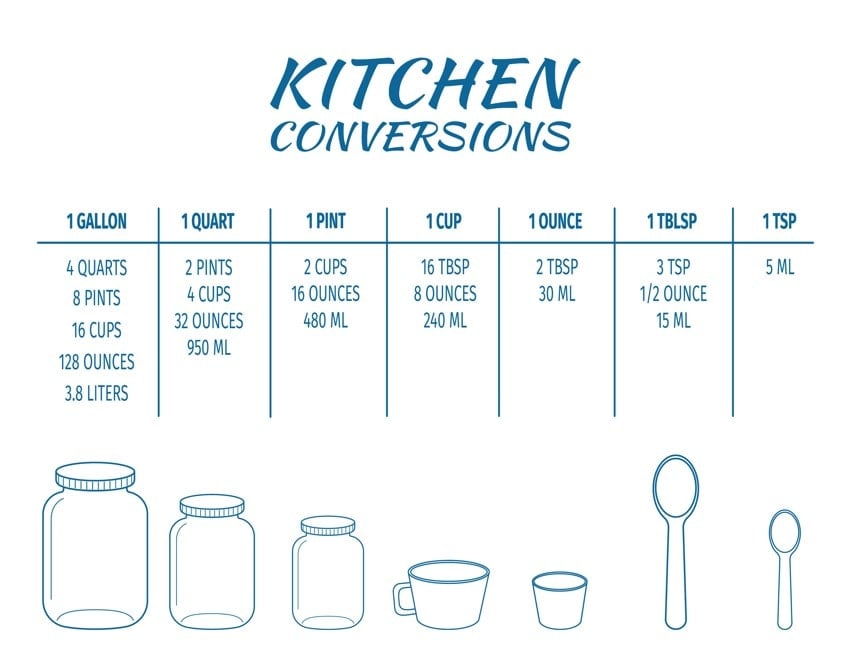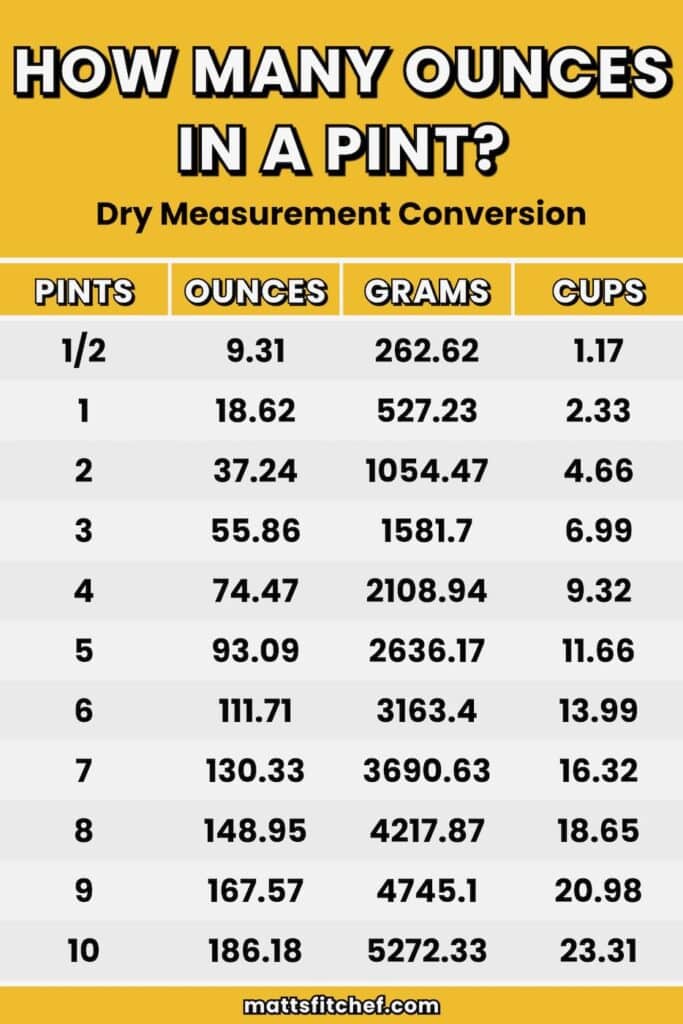How Many Ounces Are In A Pint? Your Ultimate Guide To Liquid Measurements
Alright folks, let’s dive into a topic that might seem simple but holds more depth than you’d expect. How many ounces are in a pint? This question often pops up in conversations, whether you're at the bar ordering your favorite drink or trying to follow a recipe in the kitchen. Liquid measurements can get confusing, but don’t worry, we’ve got you covered. In this article, we’ll break it down step by step, so you can confidently measure anything from beer to water without breaking a sweat.
Now, before we get into the nitty-gritty of pints and ounces, let’s set the stage. Understanding liquid measurements is crucial, especially if you’re someone who loves cooking or enjoys a good cocktail. Whether you’re a home chef, a bartender-in-training, or just curious, knowing how to convert units will make your life easier. So, buckle up because we’re about to demystify this liquid puzzle!
By the end of this guide, you’ll not only know how many ounces are in a pint but also how to convert between other units of measurement. Plus, we’ll throw in some fun facts and tips to help you ace your next trivia night or kitchen adventure. Let’s get started!
- Shauna Marie Campbell The Rising Star Of The Entertainment World
- Dave England Net Worth The Untold Story Of A Rising Star In The Entertainment World
Table of Contents
- What Is a Pint?
- How Many Ounces Are in a Pint?
- Different Types of Pints
- Conversions Made Easy
- Common Questions About Pints
- A Brief History of the Pint
- Practical Uses of Pint Measurements
- Tips for Accurate Measurements
- Tools to Help You Measure
- Conclusion: Mastering the Pint
What Is a Pint?
First things first, what exactly is a pint? Well, a pint is a unit of volume commonly used in the United States and the United Kingdom. It’s a standard measurement for liquids, and you’ve probably seen it on beer glasses, milk jugs, or even in recipes. But here’s the kicker—there are different types of pints, and they don’t all hold the same amount of liquid. Confusing, right? Don’t worry, we’ll clear that up in a bit.
Think of a pint as your go-to measurement for moderate-sized liquid quantities. It’s not too big, not too small, just right for most drinks and recipes. So, whether you’re sipping on a cold brew or whipping up a batch of soup, the pint is your trusty companion.
Why Is the Pint Important?
Let’s talk about why the pint matters so much. For starters, it’s a widely recognized unit of measurement, especially in the culinary and beverage industries. Bartenders use pints to serve drinks, chefs use them to measure ingredients, and even scientists occasionally rely on pints for experiments. It’s a versatile unit that bridges the gap between casual use and professional applications.
- Unlocking The Power Of Uva Knowledgelink Your Gateway To Success
- Dti Cop Your Ultimate Guide To Decentralized Identity Management
How Many Ounces Are in a Pint?
Alright, let’s answer the million-dollar question: how many ounces are in a pint? In the United States, one pint equals 16 fluid ounces. That’s the standard measurement you’ll find on most labels and in recipes. But hold on—this number can change depending on where you are in the world. For example, in the UK, a pint is slightly larger, clocking in at 20 fluid ounces. Crazy, right?
So, if you’re traveling or following a recipe from another country, it’s essential to double-check the pint size. Otherwise, you might end up with too much or too little liquid. Trust me, it’s happened to the best of us.
Breaking Down the Math
Let’s break it down for clarity. Here’s the basic conversion:
- 1 US pint = 16 fluid ounces
- 1 UK pint = 20 fluid ounces
See? It’s not rocket science. Just remember to check which system you’re using, and you’ll be golden.
Different Types of Pints
Now that we’ve covered the basics, let’s explore the different types of pints. As mentioned earlier, the pint varies depending on the country. Here’s a quick rundown:
- US Pint: 16 fluid ounces, commonly used in the United States.
- UK Pint: 20 fluid ounces, standard in the United Kingdom.
- Imperial Pint: Also 20 fluid ounces, used in countries that follow the imperial system.
These differences might seem minor, but they can make a big impact when you’re dealing with precise measurements. Always be mindful of the system you’re working with to avoid any mix-ups.
Why the Differences Matter
So, why do these differences exist? It all comes down to history and tradition. The US and UK systems evolved separately, leading to slight variations in their units of measurement. While it might seem inconvenient at times, it’s also a fascinating glimpse into how different cultures approach measurement.
Conversions Made Easy
Converting between units doesn’t have to be a headache. With a little practice, you’ll become a pro in no time. Here’s a handy guide to help you convert pints to other units:
- 1 pint = 16 fluid ounces (US)
- 1 pint = 20 fluid ounces (UK)
- 1 pint = 0.5 liters (approx.)
- 1 pint = 2 cups
See? It’s not that complicated. Just memorize these conversions, and you’ll breeze through any recipe or drink order.
Tools to Simplify Conversions
If math isn’t your strong suit, don’t worry. There are plenty of tools to help you with conversions. Apps, online calculators, and even kitchen scales can make your life easier. Plus, most modern measuring cups already have pint and ounce markings, so you can eyeball it if you’re in a hurry.
Common Questions About Pints
Let’s address some of the most frequently asked questions about pints. Chances are, you’ve wondered about these at some point:
- Is a pint always 16 ounces? No, it depends on the country. In the US, it’s 16 ounces, but in the UK, it’s 20 ounces.
- Can I use a pint for dry ingredients? Technically, yes, but it’s not recommended. Pints are designed for liquid measurements, so using them for dry ingredients might lead to inaccuracies.
- How do I know which pint system to use? Check the recipe or label for clarification. If it’s not specified, assume it’s the US system unless you’re in the UK or another country that uses the imperial system.
These questions might seem basic, but they’re crucial for getting accurate measurements.
Clearing Up Confusion
One common source of confusion is the difference between liquid and dry measurements. While pints are primarily used for liquids, some people try to use them for dry ingredients. This can lead to discrepancies, so it’s best to stick with the right tool for the job.
A Brief History of the Pint
The pint has a rich history that dates back centuries. Originally, it was a unit of measurement used in medieval Europe, where it varied greatly depending on the region. Over time, standardized systems emerged, leading to the US and UK pint systems we know today.
Interestingly, the word “pint” comes from the Latin word “pincta,” which referred to a mark on a container indicating its capacity. How’s that for a fun fact?
How the Pint Evolved
As trade and commerce expanded, the need for standardized measurements grew. This led to the development of the imperial system in the UK and the US customary system. While both systems use the pint, they differ slightly in size due to historical and cultural factors.
Practical Uses of Pint Measurements
Now that you know all about pints, let’s talk about how you can use them in everyday life. Whether you’re cooking, bartending, or just trying to impress your friends, pints have got you covered:
- Cooking: Use pints to measure liquids like milk, broth, or oil in your recipes.
- Bartending: Serve drinks in pint glasses for a classic pub experience.
- Gardening: Measure water for your plants using a pint-sized container.
The possibilities are endless. Get creative and see how pints can enhance your daily routines!
Maximizing Your Pint Usage
Here’s a pro tip: invest in a good set of measuring cups and spoons. They’ll make your life so much easier, especially when working with pints. Plus, they’re affordable and readily available at most stores.
Tips for Accurate Measurements
Accuracy is key when working with measurements. Here are some tips to ensure your pint measurements are spot-on:
- Use a measuring cup with clear pint and ounce markings.
- Level off your liquid to ensure precise readings.
- Double-check your conversions if you’re using a different system.
These simple steps can make a big difference in your results. Don’t underestimate the power of precision!
Common Mistakes to Avoid
One common mistake is assuming that all pints are the same. As we’ve discussed, this isn’t true. Always verify the system you’re using to avoid any mishaps. Another mistake is using a pint for dry ingredients without adjusting for density. Stick to dry measuring cups for those situations.
Tools to Help You Measure
If you want to take your measuring game to the next level, here are some tools you should consider:
- Measuring Cups: Essential for both liquid and dry ingredients.
- Kitchen Scales: Great for precise weight measurements.
- Conversion Apps: Handy for quick calculations on the go.
Investing in these tools will save you time and effort in the long run. Plus, they make great gifts for fellow foodies!
Choosing the Right Tools
When selecting tools, prioritize quality and accuracy. Look for products with clear markings and durable materials. A good set of measuring tools is an investment that will last for years.
Conclusion: Mastering the Pint
And there you have it, folks! You’re now an expert on pints and their many uses. Knowing how many ounces are in a pint is just the beginning. With this knowledge, you can tackle any recipe, mix any drink, and impress anyone who crosses your path.
Remember, accuracy is key, and practice makes perfect. So, grab your measuring cup, pour yourself a pint, and get to work. Whether you’re cooking, bartending, or just curious, the world of measurements is at your fingertips.
Before you go, don’t forget to share this article with your friends and leave a comment below. Let us know how you plan to use your newfound knowledge, and stay tuned for more tips and tricks. Cheers to mastering the pint!



Detail Author:
- Name : Alf Johnson
- Username : ondricka.pinkie
- Email : jmitchell@yahoo.com
- Birthdate : 1990-08-28
- Address : 1227 Macejkovic Station Lorineton, WY 44625-8881
- Phone : 520.970.2698
- Company : Conroy-Gerhold
- Job : Database Administrator
- Bio : Delectus sed pariatur sed assumenda. Exercitationem qui cupiditate dolorum velit ipsam et. Voluptatum ipsa voluptatem enim quam.
Socials
instagram:
- url : https://instagram.com/jazmyne_dev
- username : jazmyne_dev
- bio : Odio neque eos praesentium mollitia. Commodi ducimus deserunt eos omnis ea aut nihil.
- followers : 299
- following : 1279
linkedin:
- url : https://linkedin.com/in/jazmyne6382
- username : jazmyne6382
- bio : Iusto deserunt cumque in modi ut.
- followers : 2377
- following : 194
facebook:
- url : https://facebook.com/jazmyne.sauer
- username : jazmyne.sauer
- bio : Recusandae ut incidunt laudantium vitae nobis.
- followers : 3584
- following : 643
twitter:
- url : https://twitter.com/sauer1991
- username : sauer1991
- bio : Ullam ratione architecto molestiae consequatur consequatur nemo dolorem quam. Repellat quaerat ab voluptate aut distinctio. Veritatis velit veniam amet quidem.
- followers : 1048
- following : 1647